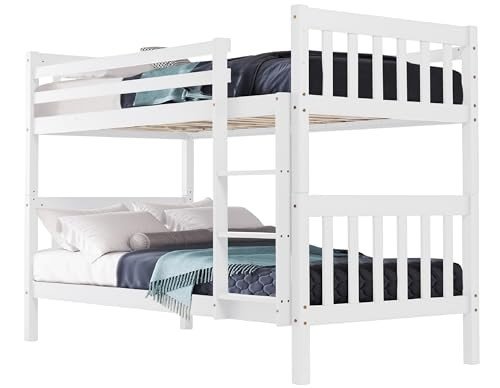15 Things You Don't Know About Kids Bunk Bed
The Ultimate Guide to Kids Bunk Beds: Maximizing Space and Fun
With the increase of vertical living and smaller sized spaces, the popularity of bunk beds has skyrocketed amongst households. Bunk beds not just use a practical sleeping option, specifically in shared rooms, however they also bring a component of enjoyable into a child's life. discover here explores the functions, advantages, and considerations of kids' bunk beds, making it much easier for moms and dads to choose the ideal bed for their children.
Functions of Kids Bunk Beds
Bunk beds are versatile pieces of furniture that serve more than a single function. Here are some key features to consider:
Feature
Description
Product
Bunk beds can be built from wood, metal, or a combination of both, using differing levels of resilience and style alternatives.
Safety Features
Most bunk beds come geared up with guardrails, safe and secure ladders, and capped assistances for security, particularly essential for young kids.
Style Variety
Alternatives vary from traditional styles to contemporary styles, making sure a match for any room design.
Space-Efficiency
Bunk beds use vertical space, making them ideal for smaller rooms.
Convertible Options
Some designs can be transformed into 2 separate beds, providing versatility as children grow.
Storage Solutions
Some bunk beds feature integrated storage drawers or racks, helping to keep the space arranged.
Advantages of Kids Bunk Beds
Investing in a bunk bed comes with several advantages:
- Space Saving: Bunk beds make the most of flooring space, allowing for more play area or storage services.
- Fun Factor: With a bunk bed, kids belong that promotes imagination and companionship during slumber parties or playdates.
- Economical: Instead of purchasing two different beds, a bunk bed can accommodate two kids at the same time, saving money in the long run.
- Flexibility: Many bunk beds can be disassembled or transformed into twin beds, making them a long-term investment as kids's requirements change.
- Social Interaction: Bunk beds encourage family bonding and relationships, providing an inviting space for children to share stories and laughter.
Factors to consider When Choosing a Kids Bunk Bed
When selecting the best bunk bed for a kid, moms and dads ought to take into consideration various aspects:
- Safety Standards: Ensure that the bunk bed abide by safety regulations and includes important security functions.
- Age Appropriateness: Different models deal with different age. For example, traditional bunk beds might not be suitable for younger kids.
- Room Dimensions: Measure the bed room to guarantee the bunk bed fits appropriately, permitting space to move around conveniently.
- Weight Capacity: Consider the weight load of each bed and ensure it accommodates the child's weight comfortably.
- Design Preferences: Letting kids get involved in the selection process can assist them feel more excited about their brand-new bed.
Kinds Of Kids Bunk Beds
Bunk beds can be found in various designs and setups to match different needs:
Type
Description
Requirement Bunk Bed
A classic style with one bed stacked on top of another, generally utilizing a ladder to access the leading bunk.
L-Shaped Bunk Bed
Functions two bunk beds connected in an L-shape, frequently more large and ideal for kids sharing a space but requiring a bit more space.
Triple Bunk Bed
Consists of 3 stacked beds, perfect for optimizing sleeping arrangements in really restricted spaces.
Loft Bed
A raised bed with space below that can serve as a backyard, study corner, or additional storage.
Futon Bunk Bed
Integrates a bunk bed on top with a futon or sofa underneath, making it great for slumber parties and optimizing room use.
Convertible Bunk Bed
Can be separated into 2 specific beds, using flexibility as kids's requirements change.
Taking Care Of Kids Bunk Beds
Preserving bunk beds is essential for guaranteeing longevity and safety. Here are some easy care practices:
- Regular Inspections: Check the bed regularly for loose screws and tightened up bolts to ensure stability.
- Cleanliness: Keep bedding clean and fresh, rotating mattresses for even wear.
- Guardrails: Ensure guardrails are safe and secure and in location, especially if kids tend to move around a lot in their sleep.
- Air Circulation: Ensure the bed has sufficient air flow, preventing wetness buildup that can result in mold or mildew.
Frequently Asked Questions About Kids Bunk Beds
Q1: At what age can a kid safely use a bunk bed?
A1: Generally, kids aged six and older are considered safe to use the upper bunk due to the height and stability aspects included.
Q2: Can I put a bunk bed near a window?
A2: It is advisable to avoid positioning a bunk bed near windows to lower the risk of falling or injuries.
Q3: Are bunk beds safe for younger kids?
A3: While some contemporary bunk beds include security features accommodating younger kids, it is normally recommended to wait up until they are older, normally over 6 years.
Q4: What is the typical weight limitation for top bunks?
A4: Weight limitations vary by model however normally vary from 150 to 250 pounds. Always refer to the producer's specs.
Q5: How often should I examine the bunk bed's security functions?
A5: It is suggested to perform a security check every couple of months or whenever you discover any signs of wear.
Kids' bunk beds act as a strategic option for households seeking to optimize space while supplying an enjoyable and appealing sleeping environment for their children. With a variety of options offered— from standard designs to loft beds— moms and dads have the liberty to choose something that meets their household's particular needs. By considering essential factors such as security, space viability, and their children's preferences, moms and dads can make an educated choice, ensuring that each kid is thrilled about bedtime while benefiting from an efficient space.
